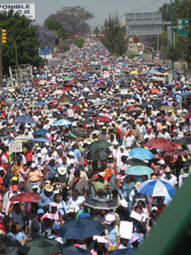Still working to recover. Please don't edit quite yet.
International Women's Day

International Women's Day (IWD) is marked on March 8 every year. It is a major day of global celebration for the economic, political and social achievements of women. The first IWD was observed on February 28 1909 in the United States following a declaration by the Socialist Party of America. Among other relevant historic events, it commemorates the Triangle Shirtwaist Factory fire (New York, 1911), where over 140 women lost their lives. The idea of having an international women's day was first put forward at the turn of the 20th century amid rapid world industrialization and economic expansion that led to protests over working conditions. Women from clothing and textile factories staged one such protest on 8 March 1857 in New York City. The garment workers were protesting what they saw as very poor working conditions and low wages. The protesters were attacked and dispersed by police. These women established their first labor union in the same month two years later.
More protests followed on 8 March in subsequent years, most notably in 1908 when 15,000 women marched through New York City demanding shorter hours, better pay and voting rights. In 1910 the first international women's conference was held in Copenhagen by the Socialist International and an 'International Women's Day' was established, which was submitted by the important German Socialist Clara Zetkin. The following year, IWD was marked by over a million people in Austria, Denmark, Germany and Switzerland. However, soon thereafter, the Triangle Shirtwaist Factory fire in New York City killed over 140 garment workers. A lack of safety measures was blamed for the high death toll. Furthermore, on the eve of World War I, women across Europe held peace rallies on 8 March 1913.
Demonstrations marking International Women's Day in Russia proved to be the first stage of the Russian Revolution of 1917. Following the October Revolution, the Bolshevik feminist Alexandra Kollontai persuaded Lenin to make it an official holiday, and it was established, but was a working day until 1965. On May 8 1965 by the decree of the USSR Presidium of the Supreme Soviet International Women's Day was declared as a non working day in the USSR "in commemoration of outstanding merits of the Soviet women in communistic construction, in the defense of their Motherland during the Great Patriotic War, their heroism and selflessness at the front and in rear, and also marking the big contribution of women to strengthening friendship between peoples and struggle for the peace". However, it didn't have too much political flavor and was an occasion for men to express their sympathy or love to the women around them - somewhat similar to Western Mother's Day and St Valentine's Day mixed together.
The day remains an official holiday in Russia (as well as in Belarus, Kazakhstan, Kyrgyzstan, Macedonia, Moldova, Mongolia, Tajikistan, and Ukraine), and is observed by men giving the women in their lives flowers and gifts. When Czechoslovakia was part of the Soviet Block this celebration was supported officially and gradually turned into parody.
During the rule of the Communist Party of Czechoslovakia in Czechoslovakia (1948–1989) the International Women's Day (in Czech: Mezinárodnà den žen, in Slovak: Medzinárodný deň žien, abbreviated as MDŽ) was used as a tool of the party propaganda, which hoped to convince women that the party cared about them and considered their needs in formulating social policy.
During the last decades of the regime, this event morphed into a parody of itself. On every March 8th almost every woman got a flower and a small gift (typically soap or a towel) from her employer. Many men took this day as a convenient opportunity to spend the day drinking in the local pub. As a result, the original aim of expressing respect and sympathy to women was completely lost. The party's ritualistic celebration of Women's Day became so stereotypical that it was even ridiculed in movies and on television in Czechoslovakia.
After the fall of socialism in Czechoslovakia (1989) MDŽ was quickly abandoned as one of the most mocked symbols of the old regime. The few attempts to reestablish the celebration have been met with sarcasm. The slightly more popular attempt to establish the Mother's Day as replacement has largely failed as well.
In Hungary Women's Day was used as a propaganda tool too, but nevertheless the custom of giving women flowers still prevails. Women usually get gifts from their employers too.
In the West, International Women's Day was commemorated during the 1910s and 1920s, but dwindled. It was revived by the rise of feminism in the 1960s. In 1975, which had been designated as International Women’s Year, the United Nations gave official sanction to and began sponsoring International Women's Day.
The 2005 Congress (conference) of the British Trades Union Congress overwhelmingly approved a resolution calling for IWD to be designated a public holiday in the United Kingdom.
Today many events are held by women's groups around the world. The global women's organization Aurora hosts a free worldwide register of IWD local events (www.internationalwomensday.com) so that women and the media can locate local activity. Many governments and organisatons around the world support IWD. For example, HSBC hosts a range of IWD activity including co-hosting of the UK's flagship IWD event with women's group Aurora. Global interest in IWD shows a steady increase.
See also
External links
- OneWorld.net's Perspectives Magazine: Women in the Lead (February/March 2006)
- www.internationalwomensday.com
- Early history of the day: short overview
- More detailed overview
- People Opposing Woman Abuse
| This article contains content from Wikipedia. Current versions of the GNU FDL article International Women's Day on WP may contain information useful to the improvement of this article | WP |